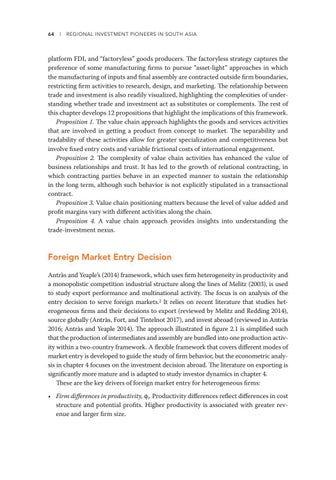64 l REGIONAL INVESTMENT PIONEERS IN SOUTH ASIA
platform FDI, and “factoryless” goods producers. The factoryless strategy captures the preference of some manufacturing firms to pursue “asset-light” approaches in which the manufacturing of inputs and final assembly are contracted outside firm boundaries, restricting firm activities to research, design, and marketing. The relationship between trade and investment is also readily visualized, highlighting the complexities of understanding whether trade and investment act as substitutes or complements. The rest of this chapter develops 12 propositions that highlight the implications of this framework. Proposition 1. The value chain approach highlights the goods and services activities that are involved in getting a product from concept to market. The separability and tradability of these activities allow for greater specialization and competitiveness but involve fixed entry costs and variable frictional costs of international engagement. Proposition 2. The complexity of value chain activities has enhanced the value of business relationships and trust. It has led to the growth of relational contracting, in which contracting parties behave in an expected manner to sustain the relationship in the long term, although such behavior is not explicitly stipulated in a transactional contract. Proposition 3. Value chain positioning matters because the level of value added and profit margins vary with different activities along the chain. Proposition 4. A value chain approach provides insights into understanding the trade-investment nexus.
Foreign Market Entry Decision Antràs and Yeaple’s (2014) framework, which uses firm heterogeneity in productivity and a monopolistic competition industrial structure along the lines of Melitz (2003), is used to study export performance and multinational activity. The focus is on analysis of the entry decision to serve foreign markets.3 It relies on recent literature that studies heterogeneous firms and their decisions to export (reviewed by Melitz and Redding 2014), source globally (Antràs, Fort, and Tintelnot 2017), and invest abroad (reviewed in Antràs 2016; Antràs and Yeaple 2014). The approach illustrated in figure 2.1 is simplified such that the production of intermediates and assembly are bundled into one production activity within a two-country framework. A flexible framework that covers different modes of market entry is developed to guide the study of firm behavior, but the econometric analysis in chapter 4 focuses on the investment decision abroad. The literature on exporting is significantly more mature and is adapted to study investor dynamics in chapter 4. These are the key drivers of foreign market entry for heterogeneous firms: • Firm differences in productivity, φi. Productivity differences reflect differences in cost structure and potential profits. Higher productivity is associated with greater revenue and larger firm size.

